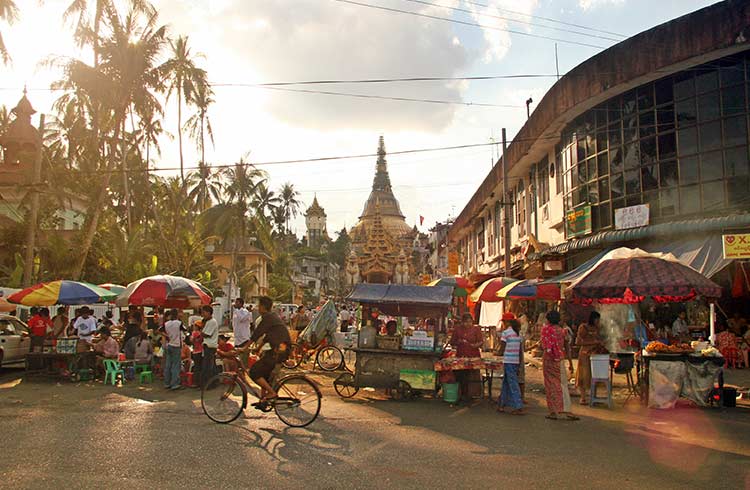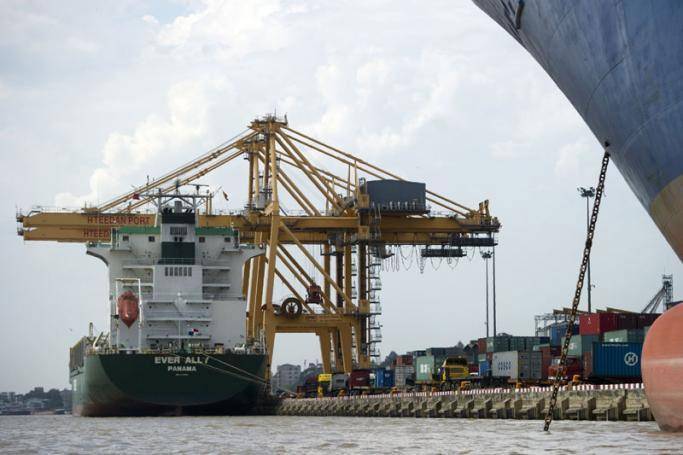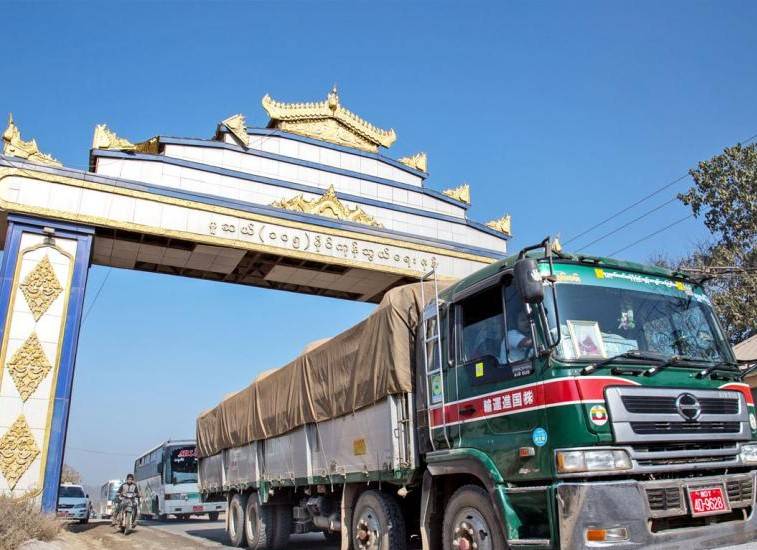Title: Healthcare B2B Forum in ASEAN
Date: 9 October 2020, 1:00 PM – 5:00 PM
Contact address: https://bit.ly/3miFnhY
Organizer: CCI France Myanmar
Title: Healthcare B2B Forum in ASEAN
Date: 9 October 2020, 1:00 PM – 5:00 PM
Contact address: https://bit.ly/3miFnhY
Organizer: CCI France Myanmar
Title: Future of career
Date: 25 September 2020, 8:00 PM
Speaker:
Moderator: Dr. Aung Htun Thet ( Chairman, UNGC Network Myanmar)
Contact address: Myanmar B2B TV
Organizer: Myanmar B2B TV and Myanmar B2B Management Magazine

Trade at Tachileik, Shan State, the border town between Myanmar and Thailand, has come to a standstill now that Thai authorities are allowing just six vehicles with a Myanmar number plate to enter Mae Sai in Thailand. The move was announced and made effective by Thai authories on September 17 as part of measures to prevent the spread of COVID-19. Initially, the Thai authorities had said 168 trucks and one driver per vehicle will be allowed to cross the No.2 Friendship Bridge between the two countries. But as it will allow only six Myanmar cars to enter Mae Sai a day, traders from Myanmar are planning to do the same.
To reciprocate, they will allow only six vehicles from the Thai side to cross over to Myanmar. Tachileik authorities have also issued new restrictions and checks on Thai drivers at the border, such as requiring Thai vehicles to register and obtain approval from the Myanmar authorities before being permitted to trade in the country at a fixed date. Thai drivers are not allowed to enter Myanmar, hundreds of vehicles are now stranded on the Thai side since September 17. More than 200 small vehicles and more than 100 trucks are now stranded in Thailand. However, their side is facing difficulty as Thai exports to Myanmar are worth more than THB 1billion per month.
Although both sides had agreed in principle to implement COVID-19 restrictions simultaneously and only after negotiations, Thailand appears to have set unilateral rules which Myanmar has since reciprocated. While border trade was going smoothly, Thai side have started to break the agreement. Now, the Myanmar side is likely to ease the restrictions only when the Thais come and negotiate after relaxing their measures. An estimate of around 200 Toyota HiAce vehicles from Myanmar and more than 100 Thai trucks pass through the Mae Sai- Tarchileik boder trade gate on a daily basis.
Source: Myanmar Times
On September 16, the ministerial – level “Joint Commission on Cooperation in the field of Trade and Industries” was held in Nay Pyi Taw and Seoul respectively. Due to COVID-19, it was organised on-line. The Joint Commission was the first of its kind as a follow-up to the summit meeting in September 2019. President Moon Jae-In of the Republic of Korea (ROK) and Daw Aung San Suu Kyi, State Counsellor, signed the MOU on establishment of the Joint Commission with a view to elevating trade and investment to a new height. The Joint Commission was well-timed as this year marks the 45th anniversary of the diplomatic relationship between the ROK and Myanmar. The ROK government has been actively pursuing the New Southern Policy, its flagship diplomatic initiative, and in that context, looks to Myanmar as the last frontier market in the ASEAN region.
The leaders’ commitment to upgrading investment and enhancing people-to-people exchanges has shown specific outcomes. The two sides are working together to identify suitable projects, which will be borne by a newly established soft loan to the amount of US$ 1 billion. The Myanmar government has granted new working licenses to three Korean commercial banks, thus making Korea the country with the highest number with a total of four licensed banks in Myanmar. A new direct flight by Myanmar Airways International, launched in past December, is another welcome development. Korea-Myanmar Industrial Complex (KMIC) is expected to draw as many as 150 to 200 Korean companies once it is up and running. Korea is working with the Myanmar side on drawing blueprint for Dala new town.
At the Joint Commission meeting, both sides reaffirmed the importance of “Korea Desk”which will serve as a one-stop shop and gateway for new investors from Korea. Over the past few years, the horizon of Korean investment has considerably widened. The successful Joint Commission meeting was a small but significant step to make Korea’s commitment to working together with its time-honored friend, Myanmar, towards the visionary and inspiring message President Moon delivered during his state visit-“Korea will be a trustworthy partner in turning Myanmar’s dream of the miracle in the Ayeyarwady river into reality”.
Source: Myanmar Times
Title: Utilizing financial support measures available for SMEs
Date: 21 September 2020, 10:00 AM- 11:00 AM
Panelists:
Contact address: https://zoom.us/webinar/register/WN_QGvyzi_HRDe1NG4EhiLZdA
Organizer: UMFCCI

Myanmar’s external trade between 1 October and 4 September in the 2019-2020 financial year touched a high of US$34.35 billion, an increase of $1.84 billion compared with the corresponding period of the 2018-2019FY, according to the Ministry of Commerce. During the same period in the previous FY, trade stood at $32.5 billion, according to the data released by the ministry. Myanmar’s foreign trade has shown a 10-per cent increase, year over year, under the incumbent government. Myanmar has already reached a total trade value of $34 billion for the current FY, said an official from the ministry.
The Ministry of Commerce is endeavouring to boost export, enhance value-added production, reduce export barriers and provide trade financing services. In the current budget year, both maritime and border trade recorded an increase compared with the year-ago period, with exports estimated at over $16.4 billion and imports valued at $17.9 billion. Myanmar exports agricultural products, animal products, minerals, forest products, and finished industrial goods, while it imports capital goods, raw industrial materials, and consumer goods.
The country’s export sector relies more on the agricultural and manufacturing sectors. Export earnings from CMP (cutting, making, and packing) garment businesses are rising, while reliance on natural resources is lessening. The government is trying to reduce the trade deficit by screening luxury import items and boosting exports. At present, CMP garment sector which contributes to over 20 per cent of Myanmar’s export sector is facing hardship due to the cancellation of order from the European countries and suspension of the trade by western countries amid coronavirus consequences. As a result of this, manufacturing export, mainly CMP garment, and raw materials imported by the CMP businesses showed a drop amid the pandemic shock, highlighted the business people.
Source: The Global New Light of Myanmar

Myanmar’s border trade with China saw a decrease of US$ 188 million between 1 October last year and late August this current financial year. The border trade between Myanmar and China through five border checkpoints was over US$5.26 billion in the current budget year, which plunged from US$5.45 billion recorded in the corresponding period of last year. The border trade between Myanmar and China reached US$4.35 billion through Muse, US$128.6 million via Lwejel, US$491.83 million via Chinshwehaw, US$279.86 million via Kampaiti, and over US$ 4.94 million via Kengtung. The ministry’s data showed a slight drop in trade value via all border trade camps between Myanmar and China, except Chinshwehaw.
A large portion of Myanmar’s overland trade with China goes through Muse border. China has been stepping up border control measures to curb the spread of the deadly coronavirus infection.The transport delays caused damage to the quality of the goods and doubled the truck fares and the growers and traders are suffering huge financial losses amid the virus. In an effort to promote bilateral trade between Myanmar and China, the two countries have been organizing trade exhibitions, seminars and workshops on a rotating basis. The two countries are making concerted efforts to create more border economic zones and boost border trade. Border trade between Myanmar and China has seen a significant growth over the past couple of years. Bilateral trade volume between the two neighbors through the border checkpoints is around US$490 million per month.
China is the largest trading partner as well as one of the most important sources of investment for Myanmar. China’s investment in Myanmar from 1988 to date was worth nearly US$21 billion which is equivalent to about 25 per cent of total FDI in the country. The largest sector of China’s investment flowed to electricity generation sector, accounting for 63 per cent, followed by the oil and gas, and mining sectors with 36 per cent and the other sector with 1 per cent. The border trade between Myanmar and China was US$5.936 billion in the financial year 2015-2016, amounted to US$5.967 billion in the financial year 2016-2017, declined to US$4.7 billion in the financial year 2017-2018, and was recorded US$ 2.5 billion during the six month interim period prior to the next financial year 2018-2019. Myanmar’s bilateral trade with China was US$10.9 billion in 2015-16 FY, US$10.8 billion in 2016-2017 FY, US$11.78 billion in 2017-2018 FY, and US$11.36 billion in 2018-2019 FY.
Source: The Global New Light of Myanmar
A second stock exchange, or pre-listing board, will be set up for the purpose of purpose of trading shares in public companies that have yet to list on the Yangon Stock Exchange(YSX). However, no futher details were provided on when this would take place. The pre-listing board is for investors to buy and sell the shares of Myanmar public companies that have yet to meet the criteria to be listed on the YSX, secondary listing boards are common to enable companies that have yet to meet main board listing criteria to raise capital by selling their shares.
This will be beneficial to small and medium-sized enterprises (SMEs) in particular, they will have the opportunity to raise capital. There are currently more than 260 public companies registered under the Myanmar Companies Law. Only six public companies are listed on the YSX. Most public companies do not meet the criteria for listing on the YSX. Establishing this market creates the right environment for unlisted public companies and exposes them to new challenges and opportunities that raise their potential of listing on the YSX in the future. The new board will be established with the approval of the Ministry of Planning, Finance and Industry and under the supervision of the SECM.
Discussions to establish a second stock exchange for public companies commenced last year. The move is also expected to create an official platform for the trading of shares in public companies. Currently, the shares are traded in the over the counter (OTC) market, which is loosely regulated. Public companies are set up with two main objectives- to raise capital from the public and compete for government tenders. They are also required to obtain permission from the SECM and other authorities and meet a list of criteria before they are officially allowed to sell their shares.
Source: Myanmar Times
A sugar glut in Myanmar has led prices to a 10-year low, as tonnes of sugar meant for export now remain in the country. There is too much sugar left in the market and the price can’t get any higher. Farmers have also started to reduce sugarcane acreage this year. According to the association’s estimates, there might be 150,000 tonnes to 200,000 tonnes of unwanted inventories in the country and prices are now between K840-K860 per viss, the lowest in over a decade. On the domestic front, “consumption has fallen drastically as there are no festivals or events during COVID-19. With people spending less, there is an impact on the sugar-rice snacks and beverage markets which in turn is having repercussions on the sugar market.
Overseas demand had fallen too. Earlier this year, Greece called off an offer to buy sugar from Myanmar at US$400 per tonne per month on a free on board system. But the future looks bleak for the sugar market. Despite lower sugarcane acreage, traders are predicting sugar prices will continue to drop in the coming months as a result of the glut and lower local consumption. There is now less than 50,000 acres of sugarcane fields in Myanmar and this is down from about 460,000 acre of sugarcane plantation before. Sesame and different types of paes are being planted instead of sugarcane.
In fact, sugar prices had already been on their way down since last year, and some 4500 sugarcane farmers from Sagaing, Mandalay and Shan State had submitted a report to the President to make their situation known. With domestic inventories piling up, the farmers also asked for a limit on sugar imports from aboard. The drop in demand and reduced sugarcane acreage has also impacted sugar mill operators further along the value chain.
Source: Myanmar Times
Travel and tourism companies in Myanmar are asking the government for additional tax relief to tie through the rest of the year. Last week, the Myanmar Travel Association submitted a letter to the Ministry of Planning and Industry seeking an extension of time to furnish required evidence before tax rates on undisclosed sources of income are raised at the start of the new fiscal year on October 1.Under the 2020 Union Tax Law, taxes on undisclosed sources of income of up to K100 million will double to 6 percent. The rates will be raised progressively until a maximum of 30pc on unassessed income above K3 billion.
Many small tourism businesses are unable to furnish the required evidence and documentation on time and are asking for the existing 3pc tax rate to be retained until at least next year. The higher tax rates at this time will place an additional burden on tourism companies which are now unable to operate with overseas travelers banned and domestic tourism at a standstill once again amid a fresh wave of local transmitted COVID-19 cases. Most of the travel and tourism companies are demanding that the government extend the timeline required to furnish the needed documents until next year. Travel companies are in a very tough situation now.
The Internal Revenue Department has been reviewing the income sources of local businesses since August 17 and will continue to do so until September 30. Even though the government has been providing one-year loans at an interest rate of 1pc to the tourism industry under the COVID-19 Economic Relief Plan (CERP), many have been left out. The Myanmar Tourism Strategic Recovery Roadmap 2021-2025 will be drawn by the Ministry of Hotels and Tourism together with the Luxemburg Development Cooperation Agency. Key strategies in the five-year plan include human resource development across the various types of tourism business in Myanmar.
Source: Myanmar Times